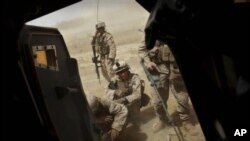President Barack Obama's plan to begin the withdrawal of U.S. troops from Afghanistan next July has caused some concern in the region, and some confusion about what the deadline means.
Mr. Obama came into office in part on a wave of voter dissatisfaction with the previous administration's handling of both the wars in Iraq and Afghanistan. As a senator, Mr. Obama was a strong opponent of the Iraq war, in part because he and others in his Democratic party believed it had diverted resources from what they saw as the more important effort in Afghanistan - the country from which the September 11th attacks were launched.
Indeed, in March of last year, just two months after taking office, the president announced his Afghanistan strategy "to disrupt, dismantle and defeat" al-Qaida, and ensure that its former Afghan hosts, the Taliban, could not return to power, and again create a terrorist safe haven. He ordered an initial increase of 17,000 U.S. troops.
In December, he further refined the strategy and announced what became known as the Afghanistan surge, 30,000 more American troops and about 10,000 from allied countries, along with full implementation of the kind of counterinsurgency strategy that generated significant progress in Iraq. But the president also made clear he was not making an open-ended commitment.
"These additional American and international troops will allow us to accelerate handing over responsibility to Afghan forces, and allow us to begin the transfer of our forces out of Afghanistan in July of 2011," he said.
The goal is to degrade the power of the Taliban and increase the size and capabilities of Afghan government security forces so the U.S. troops can begin to hand over responsibility and withdraw, a process that is expected to be gradual. But setting the July, 2011 date created concern among some in the region that that would be the end of the U.S. commitment to Afghanistan, and officials have been working ever since to dispel that notion.
They point out that the date is only the beginning of a process, and that the size and pace of the American drawdown will be determined by the amount of progress toward the two main goals - defeating the insurgents and building the Afghan forces.
Still, there is some confusion about what analyst Michael O'Hanlon of the Brookings Institution calls "a bit of a complex, nuanced message." "I think the clear overall message or takeaway is that in fact there will be the beginning of a withdrawal starting in July but, in fact, the word 'withdrawal' itself might not even be optimal. It's not so much the beginning of a departure as it is the gradual rebalancing of who does what share of the overall job," he said.
Indeed, U.S. officials prefer to talk about a "process" and a "transition," rather than a "withdrawal."
"If you think of it in those terms, then it's possible to be very firm in planning to reduce forces, but it also underscores that we're by no means rushing for the exits," O'Hanlon said.
Analyst Lisa Curtis at the Heritage Foundation says setting the July, 2011 date was a mistake, even though President Obama said it would mark only the beginning of a U.S. withdrawal. "That is what he said last December, but I think that the way it was interpreted in the region was that it was an exit strategy and that the U.S. was getting ready to withdraw," she said.
Supporters of the president's statement say it put pressure on U.S. and international institutions, and on the Afghan government, to move rapidly on programs ranging from security to governance to economic development. But Curtis says the pressure has been counterproductive and set unrealistic goals and expectations.
"There is definitely time to show signs of success, to show that the strategy has the capability achieve the objectives by next July. But I think an idea that somehow we will have prevailed over the Taliban, that we will be able to leave rapidly, in large numbers, I think that is unrealistic," she said.
Curtis says it would be wrong to leave precipitously less than a year after all the troops and international civilians had arrived, which is only happening this month. She says the United States needs a "winning strategy" rather than a deadline.
U.S. officials think they have both, and that they will be able to demonstrate progress well ahead of next July. Defense Secretary Robert Gates said as much during a U.S. Senate hearing in June.
"We think we have the right assets. We have the right strategy. We have the right leadership. And most of our allies and partners share our view that things are heading in the right direction and that we will be able to show clear progress, and that we are on the right track, by the end of this year," he said.
The end of the year is when President Obama plans a strategy review. Indeed, officials are expected to present some sort of progress report to NATO leaders at their summit November 20. That will provide the first indication of how the withdrawal and transfer of authority will proceed. But officials say it will be much closer to the deadline before they will have a firm idea of how many troops will move in July, exactly where they will come from and how quickly the drawdown will proceed after that.
What Will July 2011 Mean for US Afghan Effort?







